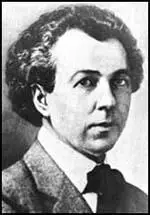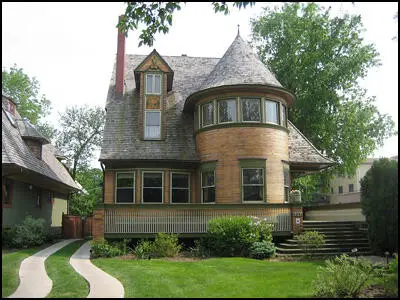Frank Lloyd Wright

Frank Lloyd Wright was born in Richland, Wisconsin on 8th June, 1867. His father, William Cary Wright, was a preacher and musician. His mother, Anna Lloyd Jones, a teacher, was the daughter of Welsh immigrants. Wright studied civil engineering at Wisconsin University and while there developed an interest in architecture.
Wright moved to Chicago in 1889 and found work with the architectural firm of Adler and Sullivan. He was greatly influenced by one of the partners, Louis Sullivan, who believed in a architecture that was "based on American themes and not on tradition or European styles".
Wright's mother joined him in Chicago and she became a volunteer worker at the Hull House Settlement. His uncle, Jenkin Lloyd Jones, a Unitarian minister, was also very involved in this community project and encouraged Wright to give free lectures at Hull House. Although Wright supported the social reform activities of Jane Addams and her followers, he was critical of the emphasis the movement placed on preserving past art and handicrafts.
In 1894 Wright established his own architectural firm in Oak Farm and began to build low-built prairie-style bungalows designed to fit into the landscape. Made of native stones and woods, Wright houses were examples of what he called organic architecture: buildings that attempted to "reflect the individual needs of the client, the nature of the site, and the native materials available."

Wright later produced more daring and controversial designs that exploited modern technology. This included the Unity Temple, America's first important architectural work in poured concrete and the Larkin Building in Buffalo, with its innovative use of metal furniture.
In 1913 Wright began work on designing the Imperial Hotel in Tokyo. Acclaimed for its earthquake resistant supporting structure, the hotel was one of the few buildings that survived the Kanto earthquake that destroyed much of Tokyo in 1923.
After the Wall Street Crash Wright received few commissions and so he concentrated on writing. This included An Autobiography (1932) and the highly influential, The Disappearing City (1932). These books renewed interest in Wright's work and this led to him producing a series of important buildings including the Johnson Wax Administration Building (1936), the Jacobs House (1937), Fallingwater (1936), Wingspread (1937), the Winckler-Goetsch House (1939) and the Florida Southern College (1940).
In his eighties Wright went into semi-retirement and wrote two more important books on architecture: The Natural House (1954) and The Living City (1959). His final work, the Guggenheim Museum, was finished shortly before his death in Phoenix, Arizona, on 9th April, 1959.
Primary Sources
(1) In 1903 Frank Lloyd Wright gave a lecture at the Hull House Settlement on architecture and technology.
Though he does not know it, the artist is now free to work his rational will with freedom unknown to structural tradition. Units of construction have enlarged, rhythms have been simplified and etherealized, space is more spacious and the sense of it may enter into every building, great or small. The architect is no longer hampered by the stone arch of the Romans or by the stone beam of the Greeks. Why then does he cling to the grammatical phrases of those ancient methods of construction when such phrases are in the modern work empty lies, and himself an inevitable liar as well.
Already, as we stand today, the machine has weakened the artist to the point of destruction and antiquated the craftsman together. Earlier forms of art are by abuse all but destroyed. The whole matter has been reduced to mere pose. Instead of joyful creation we have all around about us poisonous tastes - foolish attitudes. With some little of the flame of the old love, and creditable but pitiful enthusiasm, the young artist still keeps on working, making miserable mischief with lofty motives: perhaps, because his heart has not kept in touch or in sympathy with his scientific brother's head, being out of step with the forward marching of his own time.
The new American Liberty is of the sort that declares man free only when he has found his work and effective means to achieve a life of his own. The means once found, he will find his due place. The man of our country will thus make his own way, and grow to the natural place thus due him, promised - yes, promised by our charter, the Declaration of Independence. But this place of his is not to be made over to fit him by reform, nor shall it be brought down to him by concession, but will become his by his own use of the means at hand. He must himself build a new world.
The day of the individual is not over - instead, it is just about to begin. The machine does not write the doom of liberty, but is waiting by man's hand as a peerless tool, for him to use to put foundations beneath a genuine democracy. Then the machine may conquer human drudgery to some purpose, taking it upon itself to broaden, lengthen, strengthen and deepen the life of the simplest man. Although the power is now murderous, chained to botch-work and bunglers' ambitions, the creative artist will take it surely into his hand and, in the name of liberty, swiftly undo the deadly mischief it has created.
© John Simkin, April 2013

